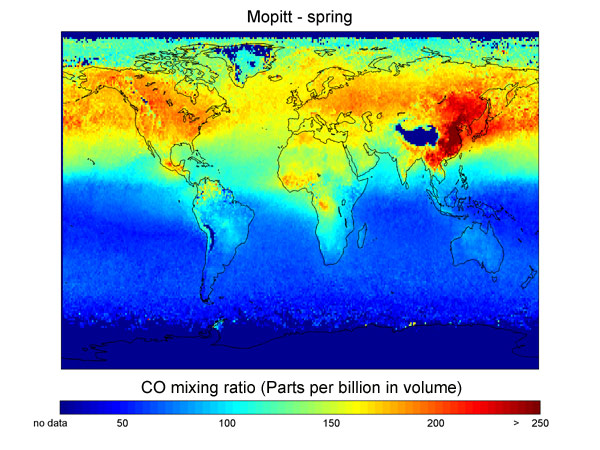Measuring atmospheric pollutants

Launch: December 18, 1999
Status: Active
MOPITT is one of five instruments launched December 18, 1999, aboard Terra, a National Aeronautics and Space Administration (NASA) satellite orbiting 705 km above the Earth. It was designed by Jim Drummond of the University of Toronto and, with the help of his science team and the Canadian Space Agency (CSA), prepared for NASA. Initially planned for a five-year term, the experiment has been prolonged because the data collected is still of high quality and the satellite is in good health. MOPITT was manufactured by COM DEV International, of Cambridge, Ontario.
Since 1999, the Canadian instrument MOPITT (measurements of pollution in the troposphere) has been continuously scanning the Earth's atmosphere to make long-term measurements of carbon monoxide concentrations. This instrument is a Canadian contribution to NASA's Earth Observing System (EOS), an international environmental study project.
Before MOPITT, measurements of carbon monoxide in the troposphere were limited and localized. The accurate and efficient MOPITT probes every part of the atmosphere in four days. The data it gathers are used in conjunction with other data gathered by the EOS project.
Information on the biosphere, atmosphere, and oceans is used by scientists to forecast the long-term effects of pollution, to understand the increase in ozone concentrations in the lower atmosphere and to orient the assessment and implementation of short-term pollution controls.
MOPITT could also be used to assess the impact of particular antipollution initiatives, such as vehicle emission reduction standards in some parts of the world. It also helps us understand the impact of other human activities, such as the combustion of biomass. The scientists analyzing MOPITT data are therefore making a great contribution to the study of environmental pollution.

This map shows the average over four years (March 2000 to February 2004) of carbon monoxide concentrations in spring. (Credit: MOPITT)
Why study carbon monoxide?
Carbon monoxide is a colourless, odourless toxic gas. It is produced by the incomplete combustion of, for example, auto fuel or biomass. It plays a key role in the chemical processes at work in the lower atmosphere. The atmosphere's carbon monoxide content has increased since the 1970s, which gives an indication of the concentrations of other gaseous pollutants such as ozone, and MOPITT will attempt to find out why.